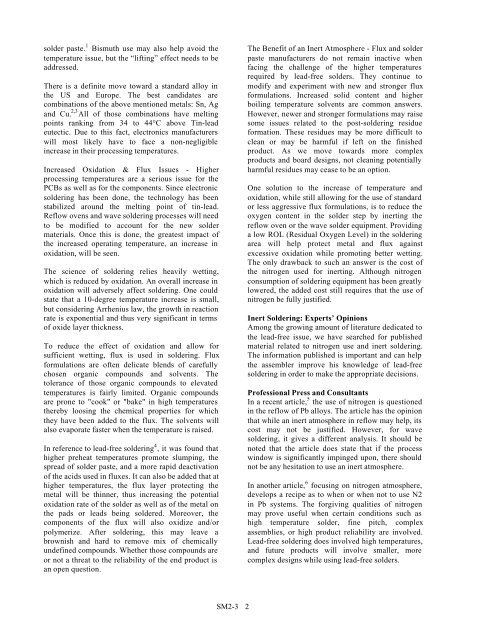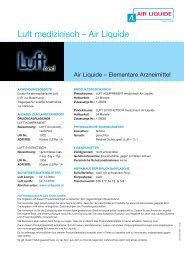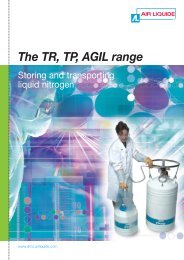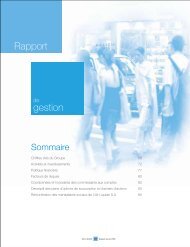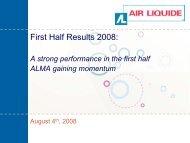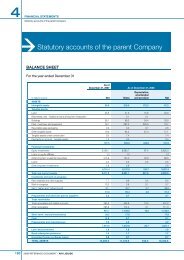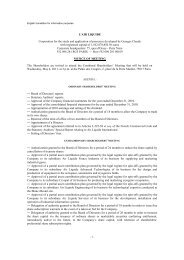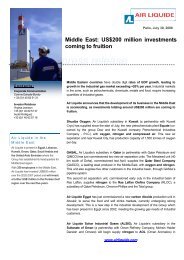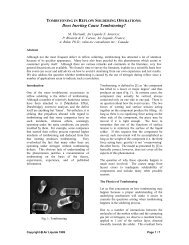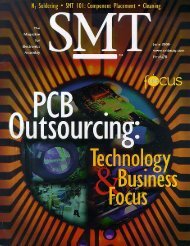Inert Soldering With Lead-Free Alloys: Review and Evaluation
Inert Soldering With Lead-Free Alloys: Review and Evaluation
Inert Soldering With Lead-Free Alloys: Review and Evaluation
You also want an ePaper? Increase the reach of your titles
YUMPU automatically turns print PDFs into web optimized ePapers that Google loves.
solder paste. 1 Bismuth use may also help avoid the<br />
temperature issue, but the “lifting” effect needs to be<br />
addressed.<br />
There is a definite move toward a st<strong>and</strong>ard alloy in<br />
the US <strong>and</strong> Europe. The best c<strong>and</strong>idates are<br />
combinations of the above mentioned metals: Sn, Ag<br />
<strong>and</strong> Cu. 2,3 All of those combinations have melting<br />
points ranking from 34 to 44°C above Tin-lead<br />
eutectic. Due to this fact, electronics manufacturers<br />
will most likely have to face a non-negligible<br />
increase in their processing temperatures.<br />
Increased Oxidation & Flux Issues - Higher<br />
processing temperatures are a serious issue for the<br />
PCBs as well as for the components. Since electronic<br />
soldering has been done, the technology has been<br />
stabilized around the melting point of tin-lead.<br />
Reflow ovens <strong>and</strong> wave soldering processes will need<br />
to be modified to account for the new solder<br />
materials. Once this is done, the greatest impact of<br />
the increased operating temperature, an increase in<br />
oxidation, will be seen.<br />
The science of soldering relies heavily wetting,<br />
which is reduced by oxidation. An overall increase in<br />
oxidation will adversely affect soldering. One could<br />
state that a 10-degree temperature increase is small,<br />
but considering Arrhenius law, the growth in reaction<br />
rate is exponential <strong>and</strong> thus very significant in terms<br />
of oxide layer thickness.<br />
To reduce the effect of oxidation <strong>and</strong> allow for<br />
sufficient wetting, flux is used in soldering. Flux<br />
formulations are often delicate blends of carefully<br />
chosen organic compounds <strong>and</strong> solvents. The<br />
tolerance of those organic compounds to elevated<br />
temperatures is fairly limited. Organic compounds<br />
are prone to "cook" or "bake" in high temperatures<br />
thereby loosing the chemical properties for which<br />
they have been added to the flux. The solvents will<br />
also evaporate faster when the temperature is raised.<br />
In reference to lead-free soldering 4 , it was found that<br />
higher preheat temperatures promote slumping, the<br />
spread of solder paste, <strong>and</strong> a more rapid deactivation<br />
of the acids used in fluxes. It can also be added that at<br />
higher temperatures, the flux layer protecting the<br />
metal will be thinner, thus increasing the potential<br />
oxidation rate of the solder as well as of the metal on<br />
the pads or leads being soldered. Moreover, the<br />
components of the flux will also oxidize <strong>and</strong>/or<br />
polymerize. After soldering, this may leave a<br />
brownish <strong>and</strong> hard to remove mix of chemically<br />
undefined compounds. Whether those compounds are<br />
or not a threat to the reliability of the end product is<br />
an open question.<br />
SM2-3 2<br />
The Benefit of an <strong>Inert</strong> Atmosphere - Flux <strong>and</strong> solder<br />
paste manufacturers do not remain inactive when<br />
facing the challenge of the higher temperatures<br />
required by lead-free solders. They continue to<br />
modify <strong>and</strong> experiment with new <strong>and</strong> stronger flux<br />
formulations. Increased solid content <strong>and</strong> higher<br />
boiling temperature solvents are common answers.<br />
However, newer <strong>and</strong> stronger formulations may raise<br />
some issues related to the post-soldering residue<br />
formation. These residues may be more difficult to<br />
clean or may be harmful if left on the finished<br />
product. As we move towards more complex<br />
products <strong>and</strong> board designs, not cleaning potentially<br />
harmful residues may cease to be an option.<br />
One solution to the increase of temperature <strong>and</strong><br />
oxidation, while still allowing for the use of st<strong>and</strong>ard<br />
or less aggressive flux formulations, is to reduce the<br />
oxygen content in the solder step by inerting the<br />
reflow oven or the wave solder equipment. Providing<br />
a low ROL (Residual Oxygen Level) in the soldering<br />
area will help protect metal <strong>and</strong> flux against<br />
excessive oxidation while promoting better wetting.<br />
The only drawback to such an answer is the cost of<br />
the nitrogen used for inerting. Although nitrogen<br />
consumption of soldering equipment has been greatly<br />
lowered, the added cost still requires that the use of<br />
nitrogen be fully justified.<br />
<strong>Inert</strong> <strong>Soldering</strong>: Experts’ Opinions<br />
Among the growing amount of literature dedicated to<br />
the lead-free issue, we have searched for published<br />
material related to nitrogen use <strong>and</strong> inert soldering.<br />
The information published is important <strong>and</strong> can help<br />
the assembler improve his knowledge of lead-free<br />
soldering in order to make the appropriate decisions.<br />
Professional Press <strong>and</strong> Consultants<br />
In a recent article, 5 the use of nitrogen is questioned<br />
in the reflow of Pb alloys. The article has the opinion<br />
that while an inert atmosphere in reflow may help, its<br />
cost may not be justified. However, for wave<br />
soldering, it gives a different analysis. It should be<br />
noted that the article does state that if the process<br />
window is significantly impinged upon, there should<br />
not be any hesitation to use an inert atmosphere.<br />
In another article, 6 focusing on nitrogen atmosphere,<br />
develops a recipe as to when or when not to use N2<br />
in Pb systems. The forgiving qualities of nitrogen<br />
may prove useful when certain conditions such as<br />
high temperature solder, fine pitch, complex<br />
assemblies, or high product reliability are involved.<br />
<strong>Lead</strong>-free soldering does involved high temperatures,<br />
<strong>and</strong> future products will involve smaller, more<br />
complex designs while using lead-free solders.


